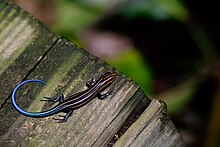Plestiodon

| Plestiodon | |
|---|---|
 | |
| Plestiodon fasciatus | |
| Scientific classification | |
| Domain: | Eukaryota |
| Kingdom: | Animalia |
| Phylum: | Chordata |
| Class: | Reptilia |
| Order: | Squamata |
| Family: | Scincidae |
| Subfamily: | Scincinae |
| Genus: | Plestiodon A.M.C. Duméril & Bibron, 1839 |
Plestiodon is a genus of lizards in the family Scincidae (skinks). The genus contains many species formerly classified under the genus Eumeces, except those now placed in Mesoscincus. They are secretive, agile animals with a cylindrical body covered with smooth, shiny scales. They are distributed from East Asia to throughout North America from southern Canada south to Mexico, including oceanic islands such as Bermuda.
Defensive mechanism
[edit]The conspicuous coloring of species of Plestiodon is a survival trait: it attracts a predator's attention to the tail of the animal, which will break off when grabbed. A skink thus often manages to escape and hide under some rock, log, or fallen leaves while the predator still contemplates the wildly thrashing severed tail. (This is an instance of what is called autotomy: voluntarily shedding a body part in order to escape, and later regenerating the body part.) After the tail regenerates, it usually has the same color as the rest of the body and is typically shorter than the original tail. In some species, regrown tails are pinkish. A regrown tail has a cartilaginous rod for support instead of vertebrae.
Reproduction
[edit]Plestiodon are all[citation needed] oviparous. The female lays eggs once a year after the breeding season in spring. The clutch size varies and is typically around 5 to 10 eggs. The hatchlings appear in late summer.
Like other reptiles, Plestiodon skinks are "cold-blooded" — they are ectothermic animals: their metabolism cannot regulate their body temperature. To warm up, they often bask in the sun. In colder climates, they hibernate in winter in burrows below the frost line. In hot climates, they are active mainly in the morning and evening, staying under cover during the hottest hours of the day to avoid overheating.
Systematics
[edit]Recently two taxonomic revisions have been made regarding the 19th century genus Eumeces. They both resulted in similar results; the genus is paraphyletic and must be "sliced up" into several different genera. Griffith et al. (2000) proposed that the type species for Eumeces, E. pavimentatus, which is considered by many to be a subspecies of Eumeces schneiderii, should be changed to Lacerta fasciata, so that the genus name Eumeces would stay with the most species-rich clade. However this petition has not been verified by the International Commission on Zoological Nomenclature. Schmitz et al. argued that Griffith et al. violated the Code and rejected the proposal on good grounds. Thus only the African species of the Eumeces schneiderii group still belong to the genus Eumeces.
Species that are now in Plestiodon:[1]
|
|
Nota bene: A binomial authority in parentheses indicates that the species was originally described in a genus other than Plestiodon.
Species that are now in Eurylepis:
- Eumeces poonaensis – now Eurylepis poonaensis
- Eumeces taeniolatus – now Eurylepis taeniolata
Species that are now in Mesoscincus:
- Eumeces altamirani – now Mesoscincus altamirani
- Eumeces managuae – now Mesoscincus managuae
- Eumeces schwartzei – now Mesoscincus schwartzei
Plestiodon brevirostris group
[edit]The Plestiodon brevirostris group consists of 14 species.[2]
- Plestiodon bilineatus, Plestiodon copei, Plestiodon dicei, Plestiodon dugesii, Plestiodon indubitus, Plestiodon lynxe, and Plestiodon parviauriculatus – highlands of the central Mexican Plateau, Sierra Madre Occidental, Sierra Madre Oriental, and Trans-Mexican Volcanic Belt
- Plestiodon lotus – Balsas Basin
- Plestiodon colimensis and Plestiodon parvulus – Pacific lowlands from northwestern Michoacán to Sonora
- Plestiodon sumichrasti – the Atlantic versant from central Veracruz south and east through northern Guatemala and Belize to Honduras
- Plestiodon brevirostris – Sierra Madre del Sur
- Plestiodon nietoi and Plestiodon ochoterenae – Sierra Madre del Sur, in south-central Guerrero and from central Guerrero to western Oaxaca
References
[edit]- ^ Genus Plestiodon at The Reptile Database. www.reptile-database.org.
- ^ a b García-Vázquez, Uri O.; Pavón-Vázquez, Carlos J.; Feria-Ortiz, Manuel; Nieto Montes de Oca, Adrián (2021). "A New Species of Blue-Tailed Skink (Scincidae: Plestiodon) from the Sierra Madre del Sur, Mexico". Herpetologica. 77 (1). doi:10.1655/0018-0831-77.1.85. ISSN 0018-0831. S2CID 232326866.
Further reading
[edit]- Austin JJ, Arnold EN (2006). "Using ancient and recent DNA to explore relationships of extinct and endangered Leiolopisma skinks (Reptilia: Scincidae) in the Mascarene islands". Molecular Phylogenetics and Evolution 39 (2): 503–511. doi:10.1016/j.ympev.2005.12.011 (HTML abstract).
- Griffith H, Ngo A, Murphy RW (2000). "A cladistic evaluation of the cosmopolitan genus Eumeces Wiegmann (Reptilia, Squamata, Scincidae)". Russian Journal of Herpetology 7 (1): 1–16. [1]
- Schmitz, Andreas; Mausfeld, Patrick; Embert, Dirk (2004). "Molecular studies on the genus Eumeces Wiegmann, 1834: phylogenetic relationships and taxonomic implications". Hamadryad 28 (1-2): 73–89. [2] [3]
- Smith HM (2005). "Plestiodon: a Replacement Name for Most Members of the Genus Eumeces in North America". Journal of Kansas Herpetology (14): 15–16. [4]
- Brandley MC, Schmitz A, Reeder TW (2005). "Partitioned Bayesian analyses, partition choice, and the phylogenetic relationships of Scincid lizards". Systematic Biology 54 (3): 373–390. [5]
- Okamoto, Taku; Motokawa, Junko; Toda, Mamoru; Hikida, Tsutomu (2006). "Parapatric distribution of the lizards, Plestiodon (formerly Eumeces) latiscutatus and P. japonicus (Reptilia: Scincidae) around the Izu Peninsula, central Japan, and its biogeographic implications". Zoological Science 23: 419–425.
- Motokawa, Junko; Hikida, Tsutomu (2003). "Genetic variation and differentiation in the Japanese five-lined skink, Eumeces latiscutatus (Reptile: Squamata)". Zoological Science 20: 97–106.